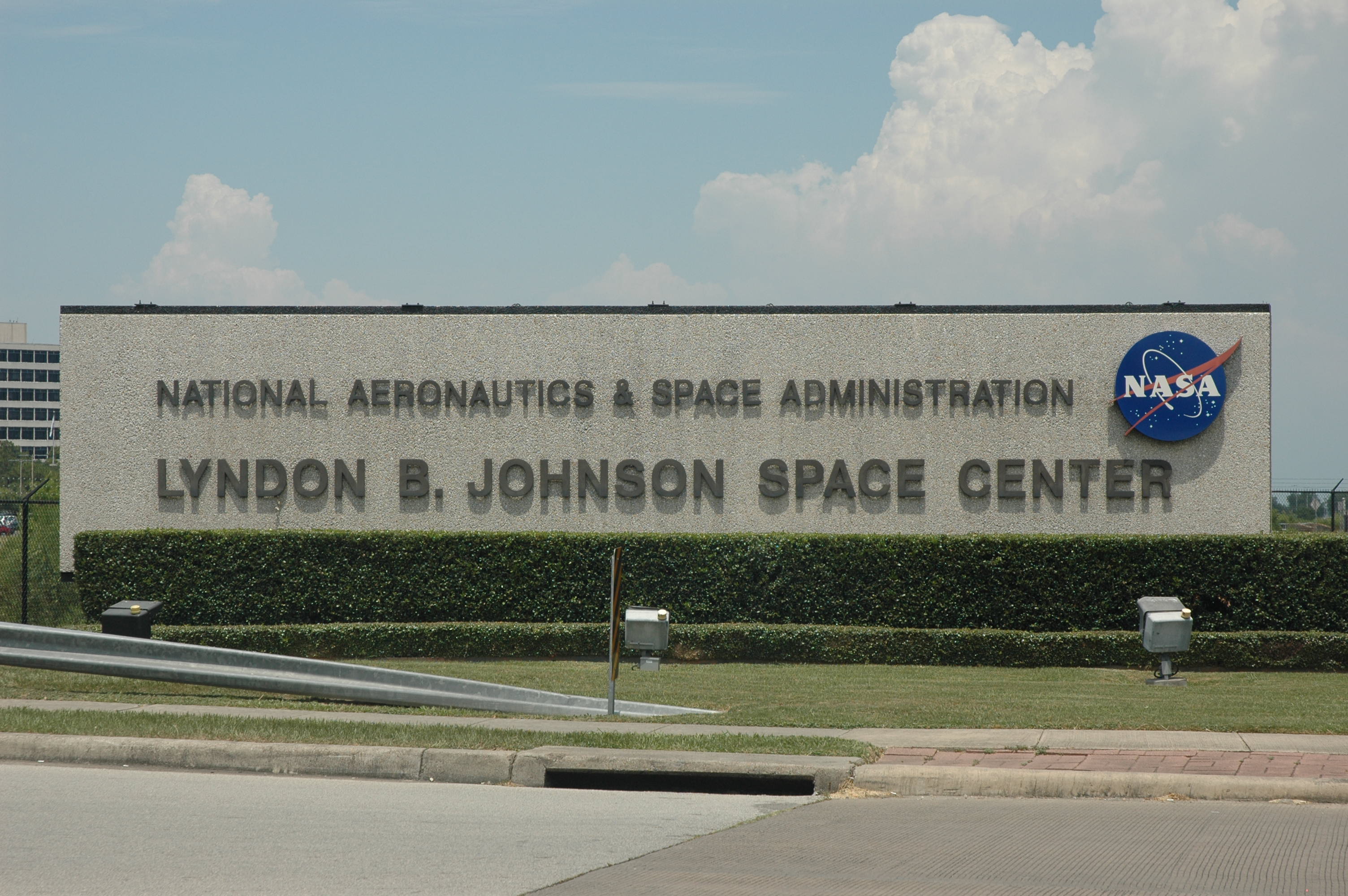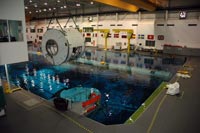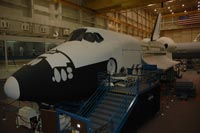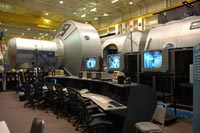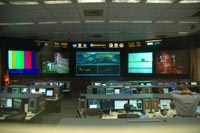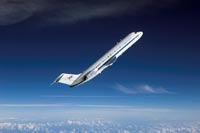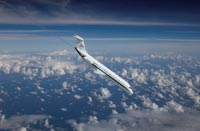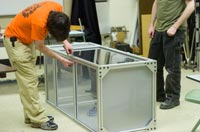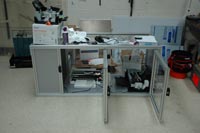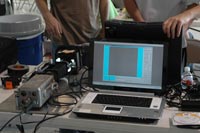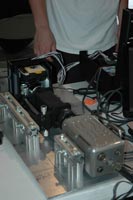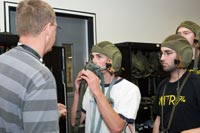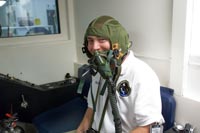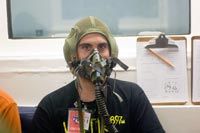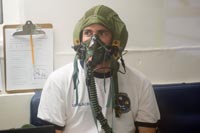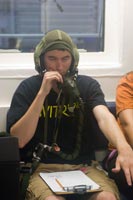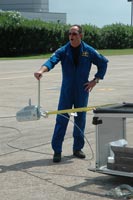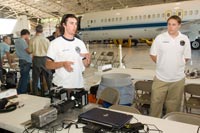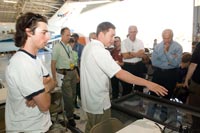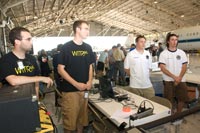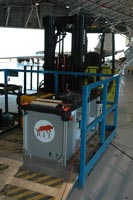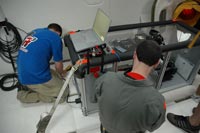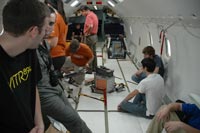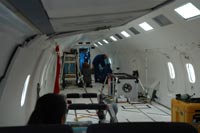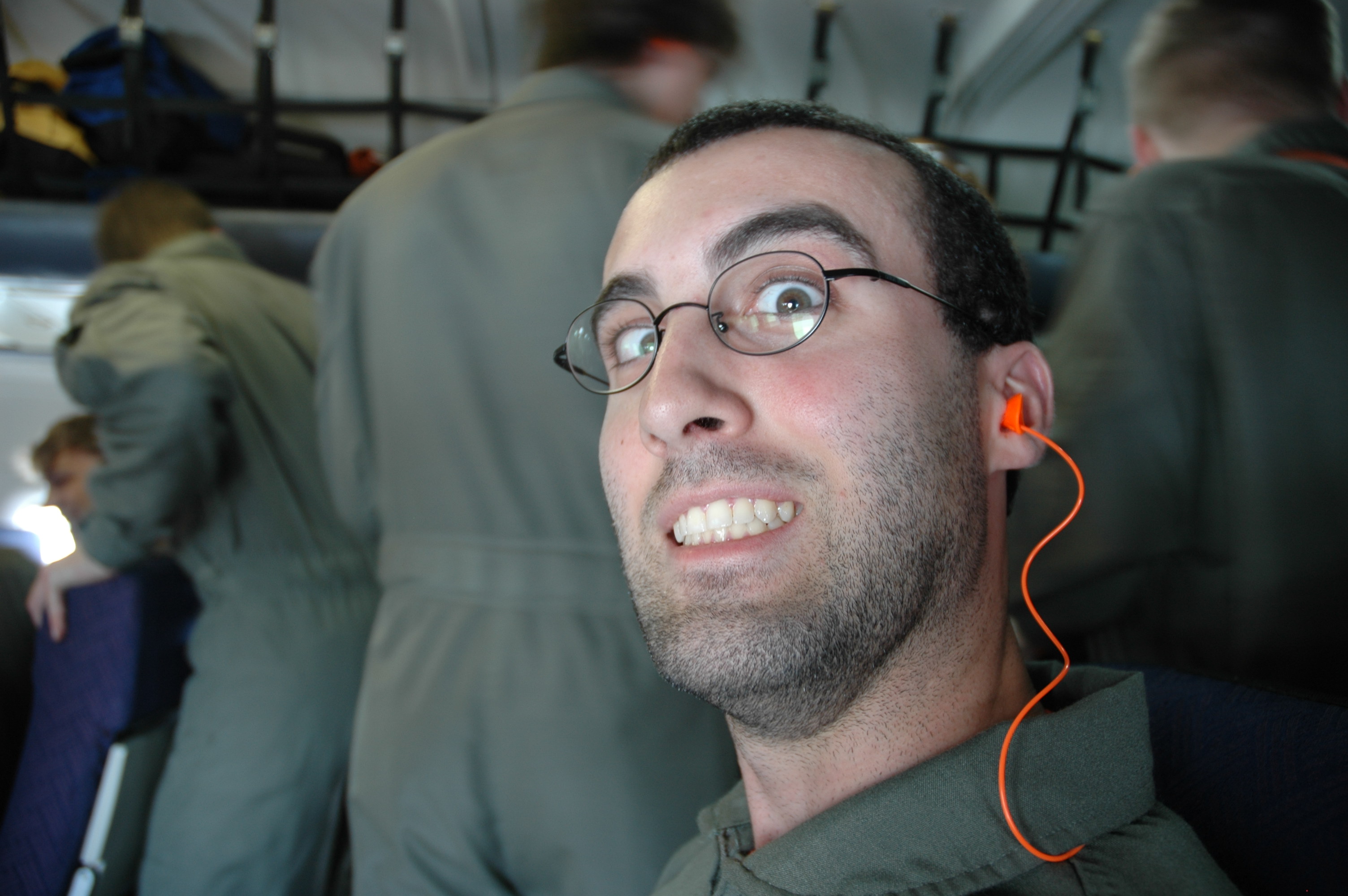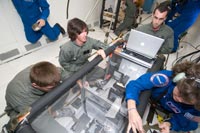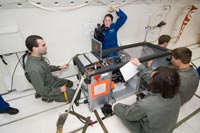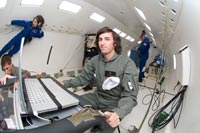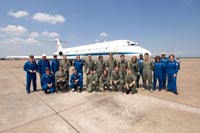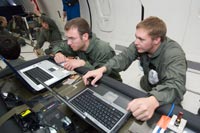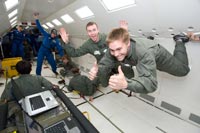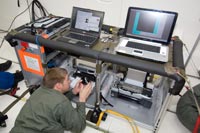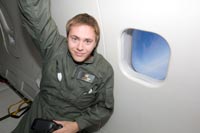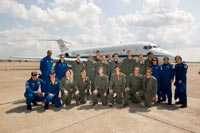2008 RIT NASA Microgravity University
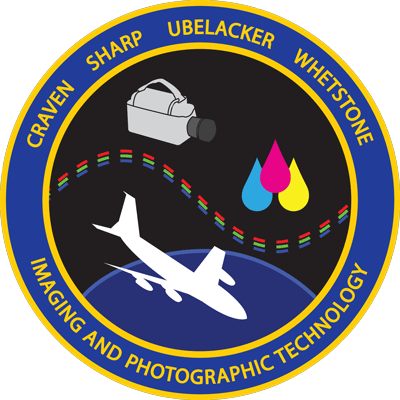
The Reduced Gravity Student Flight Opportunities Program is a NASA sponsored program where university students are given the opportunity to conduct research on the C-9 Parabolic Flight Aircraft. Approximately 40 teams per year are extended an invitation to test their experiments in microgravity aboard the aircraft. This requires the team to write a proposal, design and fabricate the equipment, participate in the flight week, and produce a final report summarizing the project and results.
The first requirement of the program is to submit a research proposal which justifies the need for intended research. These are reviewed by a panel of NASA engineers who choose the teams which have the best project proposals with the highest chance of success. If accepted into the program it is the responsibility of the team to collect funds and supplies to carry out the submitted project. The team must design and build the necessary systems and components to collect data which answers the questions posed by the project. Each project will have its own specific design challenges ranging from the complexity of the testing equipment to the safety features of the apparatus. The time from acceptance to the flight week is occupied by fabrication and testing, ensuring the equipment is ready for the flight.
During the flight week the student teams must complete a basic astronaut flight training course which includes lectures leading to an altitude chamber flight simulation. Between required training exercises and program events, time is available for necessary modifications and finishing touches to the experimental hardware. Prior to the experiment testing flights aboard the C-9 the teams are required to justify their project and prove that they are prepared to conduct their experiment. The highlight of the week, is of course is the opportunity to fly aboard the parabolic flight aircraft, where there are thirty zero-gravity, one martian, and one lunar gravity simulations.
Other activities included in the flight week are tours of the Johnson Space Center facilities. This NASA facility is home to the Saturn V Rocket, Mission Control Center, the Neutral Buoyancy Lab, and the Space Vehicle Mockup Facility which includes full scale replicas of the International Space Center and the Space Shuttle. Participants are also invited to attend a lecture by a director of future space missions and a representative of NASA human resources who presents employment opportunities.
Upon completion of the flight week the teams are required to write a research paper describing the test objectives, experiment design, results collected, and suggestions for future experiments. This article can be submitted to an academic journal if the results of the test enhance existing research or are novel findings. Each team is also required to perform outreach activities which promote the research experiment and the various NASA academic programs available.
Letter of Intent
It is optional to send a letter of intent to the director of the Reduced Gravity Student Flight Opportunities Program. Submitting the letter is not mandatory but it is good practice to inform the people in charge of the program that they can expect a proposal from your team. While it does not explicitly account for points toward the proposal score the professionalism could sway the review board in favor of teams which submit letters of intent.
Research Proposal
The first step in creating a research proposal for the program is to understand the microgravity environment and how it can be utilized for testing. This can be found in a number of NASA publications and through previous experiments which used the aircraft. Using this knowledge the team can brainstorm to find ideas which build on previous experiments or investigate new hypothesizes. Next the team must conduct background research on the potential project ideas and determine which would be the best to pursue based upon individual skills and knowledge. To do this, both internet sources and academic journals should be searched to find any and all previous work which relates to the proposed project. This is the best method to determine the academic merit and likelihood of acceptance of the potential project into the program.
The final proposal must include the project concept and the background which makes this project valuable research and worth the investment. Also included are the preliminary apparatus design and equipment required to successfully collect scientific data for analysis. To prove that that the project is both well thought out and sufficiently planned the team is required to predict, with examples citing previous research, the anticipated outcome of the project. Another key component of the proposal is in depth predictions of any potential hazards faced by the research team and the aircraft itself. This report essentially is a request for funding to use the parabolic flight aircraft with academic justification. Out of all the aspects of this program the project proposal is the most crucial because there is only one opportunity to be accepted, making it necessary to have the best possible proposal submitted by the due date.
After brainstorming several ideas the 2008 RIT team decided upon proposing the testing of inkjet printhead technologies in microgravity. There are two different inkjet designs, thermal and peizoelectric, both place small amounts of ink in the desired location accurately. The team focused on the functionality of the device as a construction tool able to precisely place nanovolume materials.
Funding and Donations
Upon acceptance into the program, the hard work begins. This includes finding funding and resources to achieve the goal of the project. Typically a project requires a significant amount of money and supplies to be donated, for everything from building the apparatus to paying for lodging while in Houston, TX. The positive side of all of this is that representing an academic institution for a project of this magnitude is conducive for getting donations and other assistance.
The Imaging and Photographic Technology department at Rochester Institute of Technology donated funds to pay for equipment and building supplies. The office of the president at RIT matched the funds raised allowing us to meet our monetary goal and fully fund the project. T-slots, a company specializing in extruded aluminum, supplied the apparatus building materials at half price. The photographic department at Johnson Space Center permitted the team use of the Phantom V9.0 digital high speed camera. The donations from the various individuals and companies allowed us to meet the research goals.
Apparatus Design and Fabrication
The largest and most time consuming element of the project was the construction of the container which was to hold the testing equipment. The end result was required to be no more than 300 lbs and fit within the dimensions of 5ft L x 2ft W x 5ft H. Using T-Slot extruded aluminum and composite paneling a fully enclosed apparatus was built. For the experiment two printers and a high speed camera assembly needed to fit within the required dimensions.
In addition a redundant safety electrical system was contained to ensure shock hazards were eliminated and in the event of a surge, the system would automatically power down. While this may seem like an easy task printers are fairly bulky and require space for paper feeding and exiting the unit. Another problem which needed to be contended with was system vibration which must be negated to result in usable photographic data. Enough room also had to be provided for minor troubleshooting in the event of an issue during flight.
Equipment Design and Fabrication
The biggest problem the team encountered was decoding the printhead interaction with the printer to achieve manual drop ejection. It was necessary to remove the printhead from the printer to allow for the macro photography to be taken. A number of things were tried for both printers and fairly simple modifications resulted in remote operation of the printers. The Epson printer had long enough ribbon cable that once removed from the printer reached to the high speed camera. The Kodak on the other required that the carriage be removed and have wires soldered to connect a second carriage. This was enough to both maintain functionality while allowing the printhead to be positioned properly in the high speed imaging system mount.
Prior to arriving in Houston, TX the team had been unable to acquire a Phantom camera to build the camera mount. This was the largest component of the project which had yet to be completed. Since the camera was not allowed to leave the facility the measurements were taken and the mount designed at Ellington Field and the actual construction completed at our accommodations. Unfortunately the team did not have access to a metal cutting saw and using a handheld saw would take several days. Thankfully an employee of NASA allowed us the use of his shop to fabricate the missing components and complete the custom camera mount.
Altitude Chamber Training
In preparation for the parabolic flight, participants are given the opportunity to experience select aspects of astronaut flight training. The highlight in this portion of the program is the Altitude Chamber Training, where the flight team participates in a lecture and equipment briefing which culminates with a simulated flight to 25,000 ft. In the chamber the flight team experiences the effects of hypoxia, which is the lack of oxygen to the body. In this simulator the partial pressure of oxygen is decreased to simulate the air composition found at the altitude of the mock flight. The aim for the altitude chamber is to allow users to experience the effects of hypoxia to recognize the symptoms and be able to take appropriate action. During the training the participates are given a paper containing questions of various difficulty. It emphasizes the effect lack of oxygen has on the mental capacity and ability to perform simple tasks.
Test Ready Review
The last and most important requirement prior to being cleared for flight is the Test Ready Review, commonly referred to as the TRR. The team is required to present their experiment to a group of NASA engineers and safety officials who make the decision as to whether or not the team is permitted to fly. The review panel listens to a 10 minute presentation which includes the abstract of the experiment, the equipment being used, and operational procedures. Working with the team a consensus is made about the necessary changes necessary to meet the test and safety requirements. In the case of the RIT team the doors of the apparatus were removed to cut down on time required for a test target to be printed along with removing potential pinch hazards.
First Microgravity Flight
The first two flyers were James Craven and Christopher Ubelacker. Prior to the flight the entire unit was double checked to ensure all systems were functioning properly. It was then loaded onto the aircraft using a forklift through the side cargo door. Inside the aircraft tape was applied to the floor where potential abrasion could result. The apparatus was positioned on top of the tape and affixed to the floor at the four corners using heavy duty cargo straps.
In the back of the aircraft there are normal airline seats where the crew and participants sit during take off, landing, and in the event of air sickness. Just minutes after take off everyone leave their seats and begin preparations, such as power up computers and loading paper, leading into the parabolas. It is recommended that the first few parabolas are used to get acclimated to the physically demanding motion of the aircraft. The flight up until this point seems fairly normal until the pilot comes over the intercom recommending that participants lie on their backs. At the bottom of the first parabola you are pinned to the floor like a centrifuge then in a surprisingly fluid motion you transition from constricted to a normal state then weightlessness. It does not register at first that you are floating in the middle of the aircraft compartment, your senses are unsure of your bearing in relation to the earth.
After two or three warm up parabolas it is time for the testing to begin. Using the Mac Laptop, documents are sent to both the printers. The first test target completes to the half way mark and the high speed camera is triggered. It was at this point the computer began to fail under the conditions within the aircraft. The laptop experienced a fatal error and crashed around the sixth parabola. Several restarts into both Mac OSX and Windows operating systems proved unsuccessful rendering the flight a failure, producing only half a test target successfully printed. It was apparent that the Mac laptop had an internal device, aside from the accelerometer which had been shut off, that was causing the computer to shut down for protection purposes. Two weeks after the flight week this problem was traced to the Hard Disk Drive that has an emergency shutoff to prevent scratching of the drive platens.
Second Microgravity Flight
The second flight was manned by Greg Sharp and Jarret Whetstone. The pressure was on to gain usable test data and it was the second flight which was to make or break the project. Since the Mac laptop was unreliable and likely to fail again two PC laptops were used. In a makeshift fashion the two laptops were affixed to the top of the apparatus using industrial Velcro. During final checks before the aircraft taxied out to the loading zone the surge protection system tripped shutting down the apparatus. Using the process of elimination it was determined that the power supply of the Phantom V9.0 High Speed camera was the cause of the issue. With two minutes before the second flight teams boarded the aircraft Chris took apart the power supply and discovered that condensation had formed between the leads inside the connector which plugs into the camera. After cleaning and reassembling the power supply he ran it out to the other team members as they were boarding, hoping that that would solve the problem.
Aboard the flight Greg and Jarret were able to achieve printed test targets from both printers and high speed imaging from one printer. The results were sufficient to meet the goal of the experiment and characterize the operational characteristics of a printer in microgravity. They were able to complete their data collection and have a few parabolas to experience microgravity the enjoyable way.
Final Report
The final report was written in the style of an SPIE journal article. Any style may be chosen and the teams justification for this format was because of their imaging background. It included an explanation of the project, the results achieved, analysis of the data, conclusion, and suggestions for future work involving this research. The report was submitted to the NASA student flight office as per the requirements of the program. The team also chose to submit the findings to the TAGA student journal which published the article.
Publication
2009 RIT TAGA Journal, Characterization of Thermal and Piezo-Electric Print Heads in a Microgravity Setting
News Coverage
RIT Team Prepares for Flight Aboard NASA’s ‘Weightless Wonder’ Article
Flying High in 2008 on the Vomit Comet Video
Imaging and Photographic Technology Department Article
Ride of a Lifetime Article
Houston, We Have Zero Gravity Article
Copyright © 2009 - 2010 TechniCapture, Inc.
